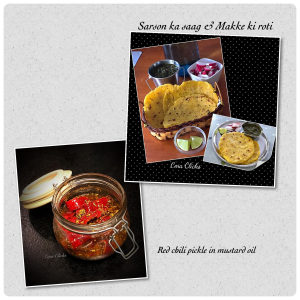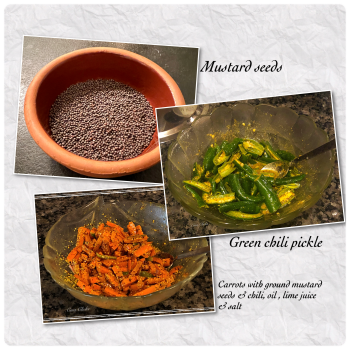Muster up Mustards
Next on my list as we continue with spices happen to be the little round black/ brown balls, pungent and strong in taste, the mustard seeds. It’s the next thing that goes into the “tadka” or tempering or “phodni” if I say it in Marathi. The seeds splutter in the hot oil and that’s how most of dals or veggies are made with the distinct flavour imparted. As I have had understood, usually when we use ghee or clarified butter as the cooking medium then, we use cumin in the tempering. These things happen mechanically, so rightly said that “the cooking happens with not only recipes from the books but the reminiscing on those little exchanges between the chefs at home over the time.”
The very first time I tasted “makkara” or “korv” with Dijon mustard & was surprised to find the taste so very familiar, though that very time I couldn’t really pinpoint as everything being so very new and then that taste lingered on and lo it was our very own mustard. That was so long ago and the times when ketchup or chutneys was what I was used to; and then this strong condiment was a refreshing change.
Next in line to experiment was the crushed mustard. Ground mustard seeds added to the chopped carrot batons to which lime juice, oil, salt and sliced green chili was added make a nice salad, and we enjoy it with rice and dal or even our chapati, flat bread and veggie. The strong taste of mustard seeds contrasts well with the sweetness of the carrots and creates a refreshing flavour on the palate.

Then our Indian pickles are made with raw mangoes, chilies, limes, vegetables like cauliflower, peas, and carrots. The process and spices differ according to each region, and many follow their own traditional hand me down home recipes. Here, when I found a raw Peruvian mango variety ended up making the pickle with ground mustard, fenugreek chili, salt, turmeric. Though the spices added could be same or sometimes may vary, the quantities added create a different flavour each time, that’s the secret of each pickle bursting with different taste and tempting our palates.
Then we have mustard greens which added to spinach and other greens like the radish leaves make the traditional “sarson ka saag (mustard veggie)” to which chopped tomatoes, onions, garlic, and ginger are added. Served with a dollop of butter and paired with “makke ki roti (flat maize bread)” makes a sumptuous meal indeed. This is usually the winter food eaten in the northern parts of India.
“All life is an experiment. The more experiments you make the better” quoting Ralph Waldo Emerson, cooking has indeed been a lot of trials and experiments as I have learnt over the years. Probably our taste too changes, like for example earlier I never cooked with the mustard oil but people in Himachal Pradesh in India as well as Bengali or Bihari cuisine use it a lot and so when one of friend suggested using mustard oil for cooking eggplant, I tried it and must say changing the medium of cooking is a game changer or a taste changer. Chili pickle that I made using the locally found red chili using mustard oil and then the different spices imparted a different distinctive taste, the oil, and the way the spices mix, and taste create a different aroma.
“May the experiments with these little spice black balls be as rewarding for you”
Seema Ganoo
Engineer by education, passionate photographer & food enthusiast from India, living in Vaasa, and is happy to contribute to this column which combines her love for food & photography.




